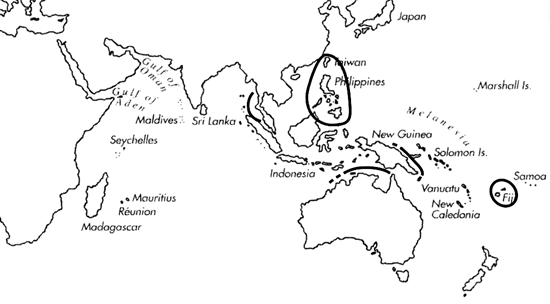
Skip Navigation Links
View access keys for this site.

Range: W. Thailand; Taiwan to Philippines; Papua New Guinea, N. Australia, and Fiji.
Description: Small to moderately small, light. Last whorl pyriform to conical or narrowly conical; outline convex at adapical two-thirds, concave to straight (right side) or concave (left side) below. Aperture very narrow. Shoulder angulate to carinate, often tuberculate, with a rather deep exhalent notch. Spire of moderate height to high, slightly stepped; outline straight to concave. Larval shell of about 2-2.75 whorls; maximum diameter about 0.75 mm. Postnuclear spire whorls tuberculate, usually weakly in last 1-2 whorls. Teleoconch sutural ramps slightly concave, with radial threads and 1 increasing to 6-8 spiral grooves and some additional striae. Last whorl with deep, regularly spaced, axially striate spiral grooves and raised ribs between; ribs sometimes replaced by narrow ribbons adapically. A darker brown form known from central Philippines (Pl. 56, Figs. 32, 33) usually with a narrowly conical and less sigmoid last whorl. Shoulder distinctly carinate, sometimes undulate to tuberculate. Larval shell of 2-2.5 whorls. Postnuclear whorls tuberculate, late whorls also carinate; tubercles often weak or absent in last 1-3 whorls. Last whorl with deeply punctate spiral grooves separating ribs basally and ribbons above. This form otherwise matching typical C. insculptus in shell morphology.
| Shell Morphometry | ||
|---|---|---|
| L | 19-30 mm | |
| RW | 0.01-0.05 g/mm | |
| RD | 0.47-0.55 | |
| PMD | 0.83-0.95 | |
| RSH | 0.20-0.29 | |
Ground colour uniformly beige to brown. Last whorl occasionally with 2-3 slightly darker obsolete spiral bands. Larval shell beige to light brown. Postnuclear sutural ramps with brown dots between marginal tubercles or a solid brown line along outer margin. Aperture white.
Habitat and Habits: In 35-150 m. In E. New Britain, in 35 m on black sand (Richards, 1988).
Discussion: C. insculptus is most similar to C. pseudorbignyi. The latter species is larger (L 32-55 mm), has a narrower last whorl (RD 0.41-0.47), and the colour pattern of its last whorl differs in bearing rows of brown dots on the spiral elevations; its larval shell has more whorls (3.5-4) and is distinctly broader (0.9-1.0 mm). C. saecularis may be similar in shell morphometry but can be distinguished by the outline of its last whorl that is straight rather than convex at the right side and concave rather than sigmoid at the left side; the last whorl is rather uniformly coloured in C. insculptus, while it has spiral rows of dots, spots and bars fusing into 2-4 spiral bands in C. saecularis. Although Kiener neither mentioned nor illustrated tubercles on the spire whorls, the species described here agrees in all other respect with the original description and is most likely conspecific with his type specimen. The darker brown shells from central Philippines were erroneously identified as C. hypochlorus by Walls ([1979]). We provisionally assign them to C. insculptus, because the differences in shell morphology do not justify separation at the species level.

C. insculptus range map
This section contains verbatim reproductions of the accounts of 316 species of Conus from the Indo-Pacific region, from Manual of the Living Conidae, by Röckel, Korn and Kohn (1995). They are reproduced with the kind permission of the present publisher, Conchbooks.
All plates and figures referred to in the text are also in Röckel, Korn & Kohn, 1995. Manual of the Living Conidae Vol. 1: Indo-Pacific Region.
The range maps have been modified so that each species account has it own map, rather than one map that showed the ranges of several species in the original work. This was necessary because each species account is on a separate page on the website and not confined to the order of accounts in the book.
Return to framed version (returns to search page)